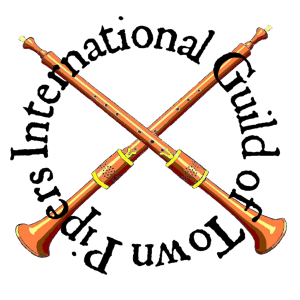Instruments played by Waits
The instrument most closely associated with Waits is the shawm – so much so that it was also known as the wait-pipe. With shawms, the slide trumpet, and later the sackbut, were often played. Later still, the unweildy bass shawm was replaced by the curtal. These loud or ‘haut’ instruments made up the typical Waits band for civic occasions, and for playing about the town at night. In the 17th century the cornett became popular, either replacing or supplementing the shawms. It appears that several bands of Waits also made use of the lysarden, or tenor cornett as well. English cornett players were generally considered the best in Europe, and the combination of cornetts and sackbuts produces a heartstoppingly beautiful and regal sound. In the 18th century, shawms, curtals and cornetts gave way to the baroque oboe and bassoon, sometimes with the addition of French horns.
The following quote is from John Evelyn – talking about the changing fortunes of the cornett:
The 21st [December, 1662], one of his Majesty’s chaplains preached, after which instead of the ancient, grave and solemn wind music accompanying the organ, there was introduced a consort of twenty-four violins, after the fantastical light way of the French – better suiting a tavern or playhouse than a church. This was the first time of the change, and now we heard no more the cornett, which gave life to the organ, for that instrument, in which the English were so skillful, was quite left off.
The cornett had lost its former popularity by around 1700. Standards had slipped by the time Roger North writes in 1695 that,
nothing comes so near or rather imitates so much an excellent voice as a cornett pipe, but the labor of the lips is too great and it is seldom well sounded.
Source: Bruce Dickey on www.concertopalatino.com
Apart from the above, the majority of Waits could turn their hand to almost any instrument, and they would be expected to play lute, viol, recorders, bagpipes, cittern, hurdy-gurdy, and later fiddle as occasion required. They were also accomplished singers, whether for church music, or singing ballads and lewd songs in the taverns.
Below are accounts of some of the instruments played by Waits. More evidence is urgently required, in order to give a broader picture.
Exeter, Devon
Exeter Waits were described by an eye witness in 1575 as having the following instruments:
“a doble Curtall, a Lyserden, two tenor Hoyboyes, a Trreble Hoyboyes, a cornet, a sett or case of ffower Recorders” (John Hooker, quoted in Langwill….. 176)
King’s Lynn, Norfolk
1398-1399 chamberlain’s accounts [KL/C/39/42] …Soluciones & ffeoda ……Item solutis Willelmo Wylde vigilatori ville pro feodo suo/per anni llljli Custus Necessarius [j emptus j tuba] ….In j Trumpet emptum pro Willelmo Wylde/xiijs iiijd [dorso] …Item remitto in manu Willelmi Wylde de providentia comunitatis j claryon pretium l marcz
1580 [KL/C7.7, fol.211v] (Congregation Book 5, 1569-91) Also yt ys agreed that Thomas Gale & other the [comen] musisions of this Towne shall have euerie of them for there wage xxs a yere and xxs for there liueries, And that there shalbe a sett of five Instrumente bought & deliuered to the sayd Thomas Gale vpon suerties to be put in for the mayntenance & safe custodye of them and so to restore & redeliver them at all tymes when they shalbe demaunded or required
(7 November) [fol. 213v] Att this daie was paid into thande of Mr Mayor for the satisfienge of Mr Bate and Mr Clark for monye Laide out by them for the Instrumente for ye waite xjli vs
1583 (29 April) [fol. 263v] Instrument dd vp by Tho. Gale./ Att this daie Thomas Gale hath deliuered into the hall heare a sett of ffive Instrumente called waite Trumpette & iij Collers with the Chaines belonginge to them belonginge to the Town.
1583 (4 October) [fol. 275] And that the said Iohn Allyn shall have the Townes sett of v instrumente or waite with the iij collers & the Trumpette deliuered vnto hym vpon suerties to be putt in for the mayntenaunce & saffe custodye of them and so to retorne restore & redeliuer them att all tymes whensoeuer the same shalbe demaunded or required.
1593 (1 October) [fol. 35] Allso their is Dd out of the hall heare att this Daie to the said Iohn Whitehead & others of his companye theise Instrumente belonginge to the Town followinge viz a Doble Curtall a single Curtall Twoo Lizardines & a Tenor hoboye./…… Allso the iij waite collers with scutchinge of the Towns armes to the same [of syluer] are dd to mr Maior to be dd to the waite att mr maiors Discreton
1597 (28 April) [fol. 128v] instruments dd to the waite Also the same daye there was dd out of the Hall heare to the iiijer Town wayte the syluer cheane with the scutchyn for the vth [<…….>] man newlye come in in the place of o<ne> which departed awaye and allso an instrument called a Lyserdine & a Trumpett
Leicester
The new corporation which came into office in 1836 decided that “the true dignity of the mayoralty does not consist in antiquated pageantry” and proceeded to abolish many of the offices, including that of the waits. In the zeal for reform corporation plate, maces and other ancient symbols were sold by public auction, along with the waits’ silver badges and instruments (two horns, two clarinets, four piccolos and a bassoon).
The Minstrels and Waits of Leicester by John C Brysdon The Musical Times May 1948
City of London
The use of new instruments by the City of London Waits, from “Apollo’s Swan and Lyre” by Richard Crewdson:
The Court of Aldermen purchased for the waits the following instruments to augment their shawms:
sackbuts in 1526, 1555, 1559, 1581 and 1597
“certain instruments called a set of vialles” in 1561
“a whole set of recorders” in 1568
a curtal in 1597
